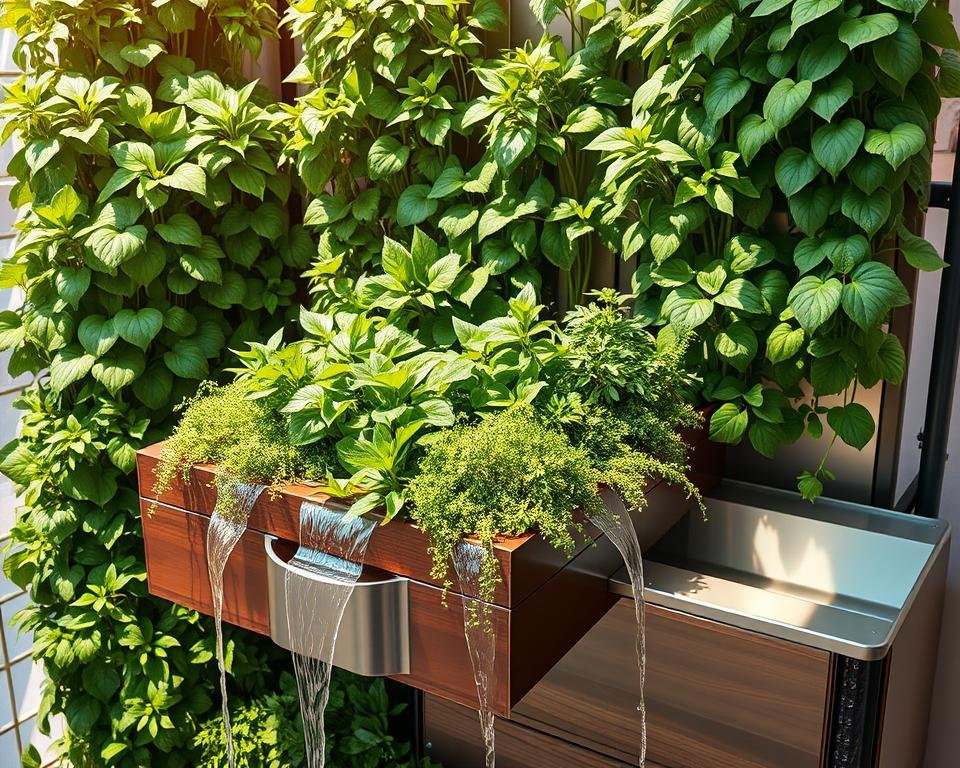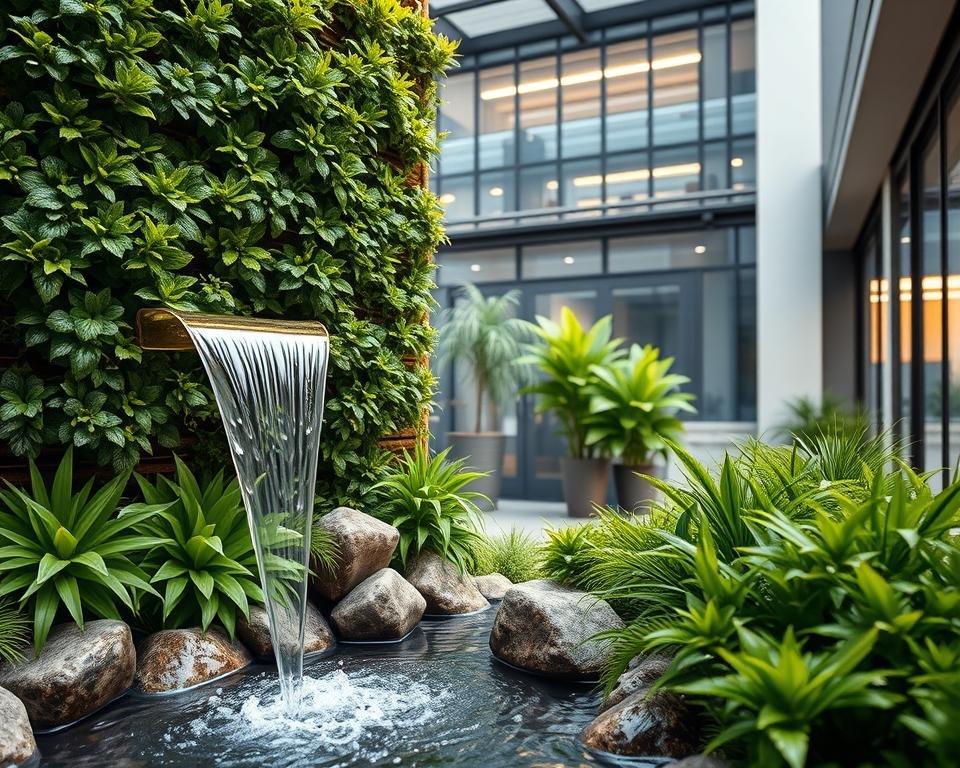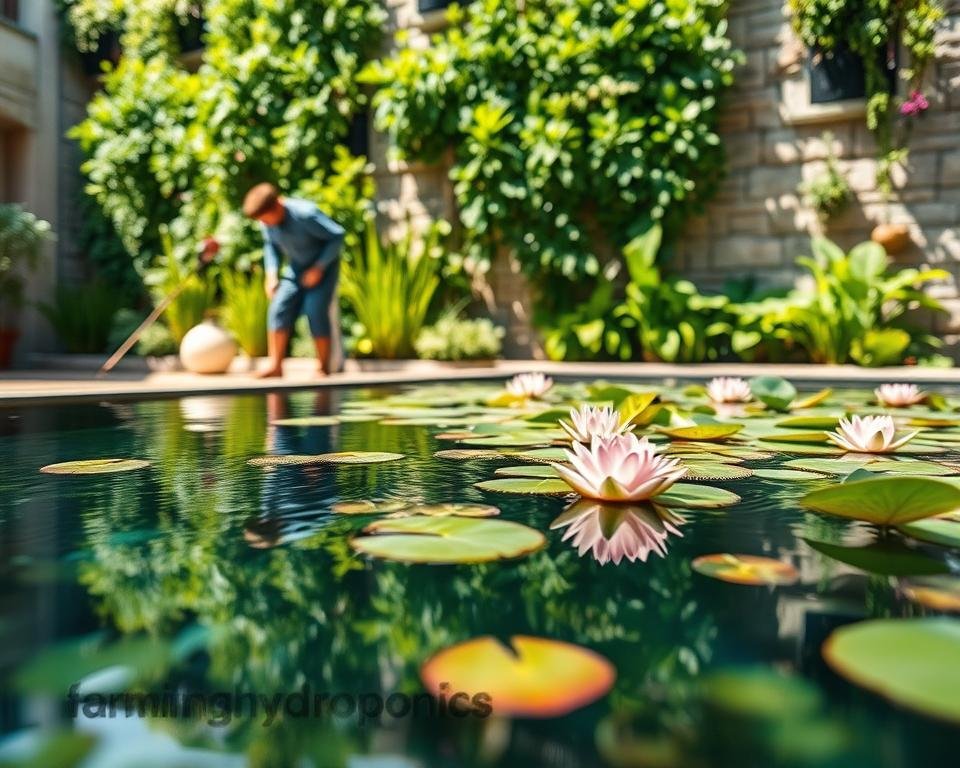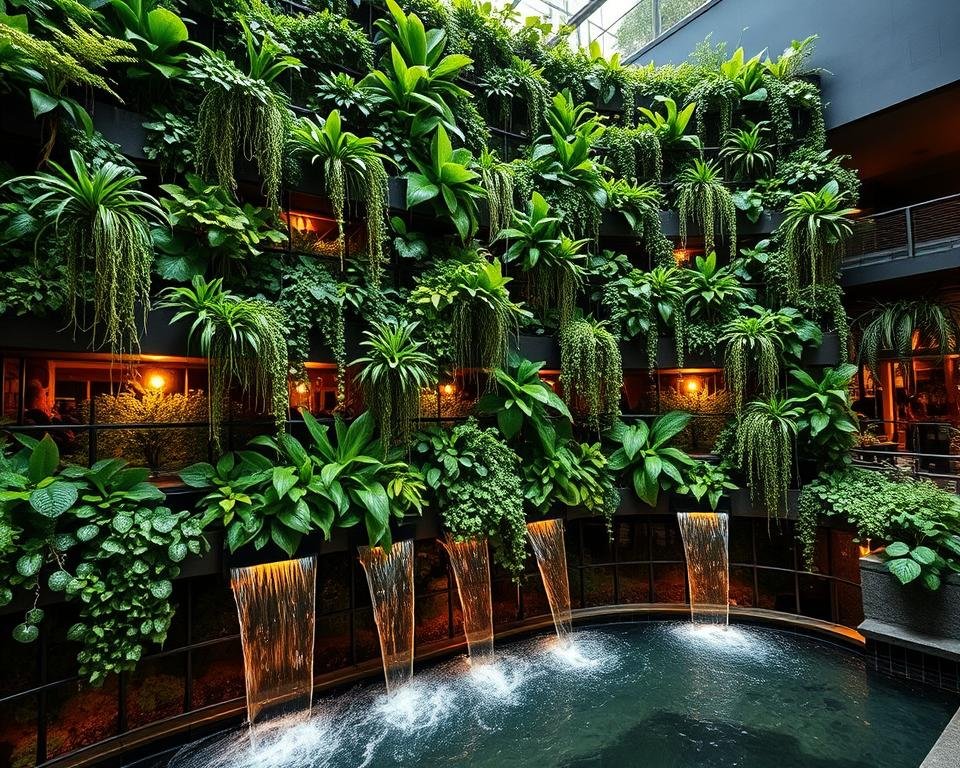Incorporating Water Features into Your Vertical Garden
Imagine turning your city space into a living oasis. Water features in vertical-gardens do more than look good. They create spaces that feel alive and connect you with nature.
Biophilic design changes how we see gardens, even in cities. Adding water features to your vertical garden makes it a living, breathing part of your space. It’s not just about looks; it’s about creating a healthy environment for plants and people.
Water features in vertical-gardens do more than add beauty. They keep plants moist, create cozy spots, and turn hard city areas into green spaces. Whether you have a small balcony or a big rooftop, these ideas can make your space greener and more alive.
Key Takeaways
- Water features enhance vertical-garden aesthetics and functionality
- Biophilic design principles support mental and physical well-being
- Innovative water systems can transform urban spaces
- Vertical-gardens with water features support plant health
- Design flexibility allows customization for any space
Understanding the Benefits of Water Features in Vertical Gardens
Turning your outdoor area into a peaceful spot starts with adding water features to your vertical-garden. These elements do more than look good. They create a full experience that can make your living space better.
Water features in gardens bring many benefits, not just looks. Studies show that nature-inspired designs can change how we act and feel.
Creating a Calming Atmosphere
The soft sounds of a fountain can make your garden a calm place. Research says water features can make outdoor time 30% more enjoyable. They create a peaceful feel that lowers stress and helps us relax.
Environmental Impact and Benefits
Water gardens are more than pretty—they’re good for the planet. Here are some environmental pluses:
- Attract helpful wildlife like birds and butterflies
- Improve local air quality
- Create natural cooling effects
- Promote biodiversity in homes
Supporting Plant Health and Growth
Vertical water features give plants the moisture they need. They create special environments that help plants grow well. The steady water supply keeps plants in the best condition.
| Water Feature Type | Benefits | Space Efficiency |
|---|---|---|
| Pondless Fountains | Low maintenance, child-safe | High |
| Wall-Mounted Spouts | Oxygenates water, attracts wildlife | Medium |
| Solar-Powered Features | Eco-friendly, sustainable | Low |
Adding water features can raise your home’s value by 20%. They’re a smart choice for both looks and money.
Designing Your Vertical Garden Water System
Creating a water system for your vertical garden needs careful planning. It’s important to think about both how it works and how it looks. This will help you make the most of your space.

Start by looking at your space and garden layout. Urban areas can be tricky for vertical-gardens. So, managing water well is key.
- Evaluate available space and sunlight exposure
- Determine optimal water source locations
- Select appropriate irrigation methods
- Consider plant-specific water requirements
There are many ways to design your water system. Drip irrigation systems are great because they save water and help plants grow well. You can set them up to give just the right amount of water to each plant.
| Water System Type | Efficiency Rating | Maintenance Level |
|---|---|---|
| Drip Irrigation | High | Low |
| Manual Watering | Medium | High |
| Automatic Sprinkler | Medium | Low |
In small urban spaces, creative water designs can be a big help. Think about using wall-mounted systems. They fit well with your garden and make watering efficient and pretty.
Types of Water Features for Vertical Gardens
Water features turn vertical-gardens into lively, sensory spots. Choosing the right one can make your garden look and feel better.
When picking a water feature, think about your space, design, and the weather. Fountains are very popular, thanks to their beauty and the need for them in dry areas.
Wall-Mounted Waterfalls
Wall-mounted waterfalls are great for small vertical gardens. They add:
- Space-saving design
- Dramatic visual impact
- Soothing water sounds
- Cooling effect for plants
Drip Irrigation Systems
Drip irrigation systems are smart for water use in vertical gardens. Fountains with drip technology give plants just the right amount of water.
Benefits include:
- Less water waste
- Targeted watering
- Less chance of too much water
- Uses less energy
Cascading Fountains
Cascading fountains add excitement to vertical gardens. Their popularity has grown, with sales doubling in just a year.
Outdoor waterfalls and ponds can be made from:
- Concrete
- Fiberglass
- Stainless steel
- Natural stone
Think about sunlight, weight, and upkeep when choosing a water feature. Solar fountains need sunlight but can grow algae if too sunny.
Installation and Technical Considerations

Starting a successful aquatic landscaping project needs careful planning and technical skills. Your water feature installation starts with knowing the key parts for a smooth fit in your vertical garden.
Important technical points for your water feature include:
- Water pressure needs (35-65 psi recommended)
- Right drainage system design
- Electrical and plumbing setup
- Pump and filtration system choice
When setting up your water feature, you must think about a few key things. Water speed should be under 5 feet per second to avoid pipe damage. Building a backyard water feature costs between $3,360. Waterfalls can add $500-$4,300 more.
Pump and filtration systems are vital for a successful aquatic garden. Spend $50-$2,000 on good equipment for water flow and plant health. Look at these important factors:
- Water volume capacity
- Energy efficiency
- Noise levels
- Fit with vertical garden design
Testing the water is crucial. Check pH, ammonia, nitrites, and nitrates to keep your aquatic garden healthy.
Strategic water feature installation makes your vertical garden truly special.
Maintenance and Care Tips for Water Features
Keeping your water features in top shape is key for your garden’s beauty and function. Proper care means they last longer, avoid expensive fixes, and stay looking great.

Regular upkeep is vital for your water features’ health and look. Experts suggest a detailed plan to keep your gardens in top condition.
Regular Cleaning Procedures
Cleaning your water features needs a careful plan. Here are key steps for keeping them clean:
- Clean the pump monthly, if you live in a leafy area
- Use a 50/50 mix of white vinegar and water to fight mineral buildup
- Take out debris and organic stuff every week
- Use skimmers or nets to keep the water surface clear
Water Quality Management
Keeping water quality right is key for your garden’s health. Here are some tips:
- Check pH levels often
- Add beneficial bacteria to break down waste
- Use algaecide when algae shows up
- Watch ammonia, nitrites, and nitrates
“Proper water quality management can reduce maintenance issues by up to 30% and keep your water features looking pristine.” – Landscape Design Experts
Seasonal Maintenance Requirements
Each season has its own challenges for water features in vertical gardens. Here’s a seasonal maintenance guide:
- Spring: Remove winter debris, check for damage
- Summer: Keep an eye on water levels and algae
- Fall: Clear leaves and trim plants around
- Winter: Use winterization methods to protect against freezing
By sticking to these maintenance tips, your water features will stay a beautiful highlight of your garden. They’ll add value and beauty to your outdoor space.
Enhancing Your Vertical Garden with Lighting and Accessories
Make your vertical garden stand out with the right lighting and accessories. The right lights can make your indoor and outdoor water features look amazing. They create a beautiful atmosphere that makes your garden even more enjoyable at night.
Here are some lighting options to take your vertical garden to the next level:
- LED waterproof lights for dramatic underwater effects
- Solar-powered accent lights for eco-friendly illumination
- Color-changing lights to create dynamic visual experiences
- Soft pathway lighting to highlight water feature surroundings
Accessories are key to making your water features unique. Decorative elements can turn a simple setup into a stunning centerpiece. Add these to enhance your design:
- Smooth river stones
- Sculptural water-resistant art pieces
- Aquatic plants that complement your design
- Reflective surfaces to amplify light and movement
When picking lighting and accessories, choose a theme that shows off your style. Research shows that well-designed green spaces can boost mental health by up to 75%. Your water feature can be a visual treat and a source of calm.
Pro tip: Use lighting to create depth and drama in your vertical garden, transforming it from a simple green space to an enchanting nighttime landscape.
Conclusion
Adding water features to your vertical garden is a smart move for urban landscaping. These elements bring beauty and benefits to your space. They offer a unique experience that goes beyond regular gardening.
Having a vertical garden with water can help you relax and improve the environment. About 60% of homeowners feel more calm after adding water features. The sound of water and green plants create a peaceful spot that boosts your mood and cools the city heat.
Water features in vertical gardens are good for the planet too. They can save up to 90% of water with recirculating systems. This makes them a green choice for city living. They also help plants, attract animals, and can even raise your home’s value by 15% in cities.
As cities grow, your vertical garden with water features is a smart choice. It’s not just a garden; it’s a living system that connects you with nature in a new way.







